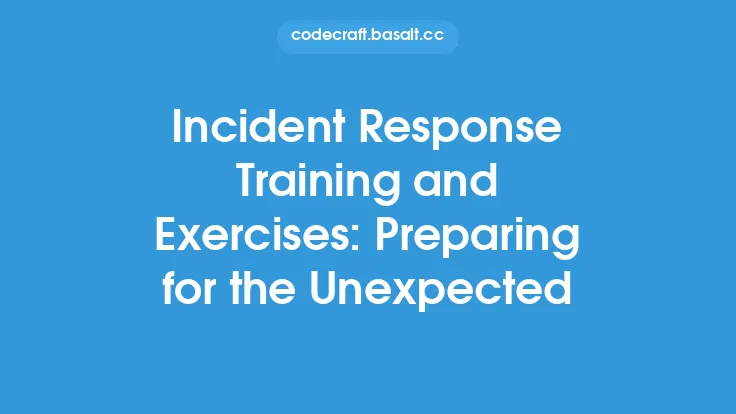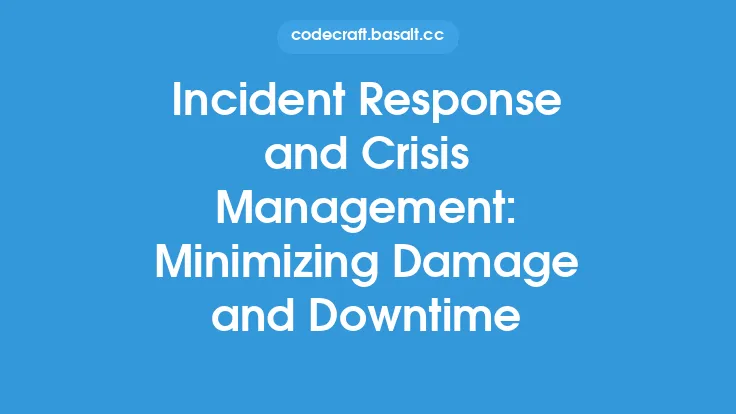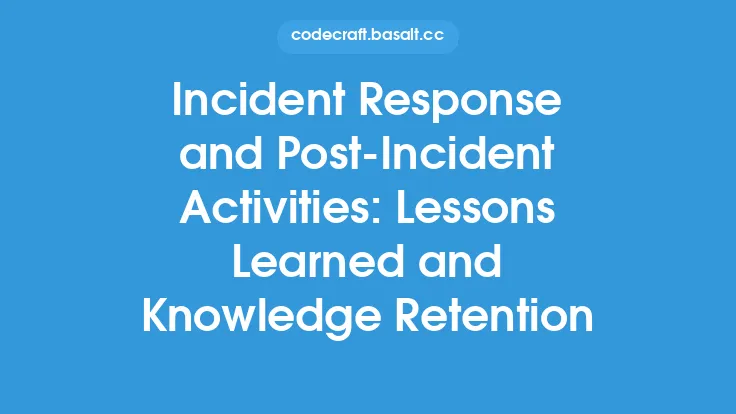Incident response planning is a critical component of an organization's cybersecurity strategy, as it enables them to respond quickly and effectively to security incidents, minimizing damage and downtime. A well-planned incident response strategy can help organizations to reduce the risk of a security breach, detect and respond to incidents in a timely manner, and minimize the impact of a breach on their business operations.
Introduction to Incident Response Planning
Incident response planning involves developing a comprehensive plan that outlines the steps to be taken in the event of a security incident. This plan should include procedures for incident detection, containment, eradication, recovery, and post-incident activities. The goal of incident response planning is to ensure that an organization is prepared to respond to security incidents in a timely and effective manner, minimizing the impact on their business operations.
Key Components of Incident Response Planning
There are several key components of incident response planning, including:
- Incident classification: This involves categorizing incidents based on their severity and impact on the organization. This helps to ensure that incidents are prioritized and responded to accordingly.
- Incident response team: This team is responsible for responding to security incidents and should include representatives from various departments, including IT, security, and communications.
- Incident response procedures: These procedures outline the steps to be taken in the event of a security incident, including incident detection, containment, eradication, recovery, and post-incident activities.
- Communication plan: This plan outlines how the incident response team will communicate with stakeholders, including employees, customers, and the media.
- Training and exercises: Regular training and exercises are essential to ensure that the incident response team is prepared to respond to security incidents.
Best Practices for Incident Response Planning
There are several best practices for incident response planning, including:
- Develop a comprehensive incident response plan: This plan should include procedures for incident detection, containment, eradication, recovery, and post-incident activities.
- Conduct regular risk assessments: Regular risk assessments can help to identify potential security threats and vulnerabilities, enabling organizations to take proactive measures to prevent incidents.
- Implement incident detection and response tools: Tools such as intrusion detection systems and security information and event management (SIEM) systems can help to detect and respond to security incidents.
- Establish incident response metrics: Metrics such as incident response time and incident containment time can help to measure the effectiveness of an organization's incident response plan.
- Continuously review and update the incident response plan: The incident response plan should be regularly reviewed and updated to ensure that it remains effective and relevant.
Technical Aspects of Incident Response Planning
From a technical perspective, incident response planning involves several key components, including:
- Network segmentation: This involves dividing the network into smaller segments, each with its own set of access controls and security measures. This can help to prevent the spread of malware and unauthorized access to sensitive data.
- Encryption: Encryption can help to protect sensitive data, both in transit and at rest. This can help to prevent unauthorized access to sensitive data, even if it is compromised.
- Intrusion detection and prevention systems: These systems can help to detect and prevent security incidents, such as malware and unauthorized access to the network.
- Security information and event management (SIEM) systems: These systems can help to detect and respond to security incidents, by monitoring and analyzing security-related data from various sources.
Incident Response Plan Development
Developing an incident response plan involves several steps, including:
- Conducting a risk assessment: This involves identifying potential security threats and vulnerabilities, and assessing the likelihood and potential impact of a security incident.
- Developing incident response procedures: These procedures should outline the steps to be taken in the event of a security incident, including incident detection, containment, eradication, recovery, and post-incident activities.
- Establishing an incident response team: This team should include representatives from various departments, including IT, security, and communications.
- Developing a communication plan: This plan should outline how the incident response team will communicate with stakeholders, including employees, customers, and the media.
- Testing and reviewing the incident response plan: The incident response plan should be regularly tested and reviewed, to ensure that it remains effective and relevant.
Incident Response Plan Implementation
Implementing an incident response plan involves several steps, including:
- Training the incident response team: The incident response team should be trained on the incident response plan and procedures, to ensure that they are prepared to respond to security incidents.
- Conducting regular exercises and drills: Regular exercises and drills can help to ensure that the incident response team is prepared to respond to security incidents.
- Implementing incident detection and response tools: Tools such as intrusion detection systems and SIEM systems can help to detect and respond to security incidents.
- Establishing incident response metrics: Metrics such as incident response time and incident containment time can help to measure the effectiveness of an organization's incident response plan.
- Continuously reviewing and updating the incident response plan: The incident response plan should be regularly reviewed and updated, to ensure that it remains effective and relevant.





